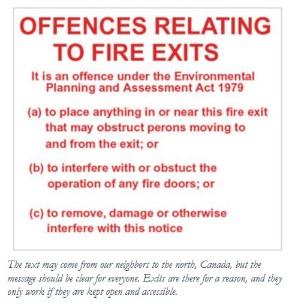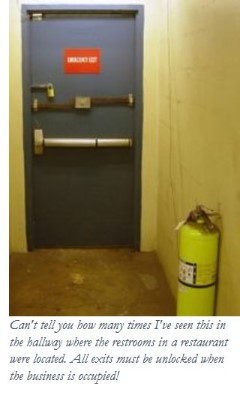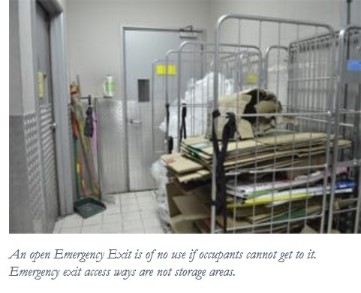.png)
OAKLAND — Two years before 36 partygoers died in the Ghost Ship warehouse inferno, Oakland firefighters toured the cluttered firetrap, even dancing in the same second-story performance space where the victims would huddle in their final moments, according to witnesses and documents.
So begins an article from the on-line edition of The Mercury News that first appeared on line on May 7, 2017: Exclusive: Oakland firefighters attended party at Ghost Ship, witnesses say" I urge you to read the entire story before continuing to my commentary

For all my years as a firefighter, officer, and now retired fire officer, I've heard firefighters say--with deep conviction--"It's not a job, it's a calling."
Well, if it's a calling, then you must be ready to "answer the call" when and wherever it comes in. Mrs. Avsec still "gives me the business" every time after we go into a restaurant for dinner and I ask to speak to the manager to point out to him or her that the half-dozen high chairs stacked up in front of the identified fire exit should be removed.
I do it politely and take the opportunity to inform and educate them about the exit requirement. But I do it. Every time. Because I could never live with myself if I picked up the morning paper and saw...
I posted The Mercury News story on LinkedIn with the follow comments:
- If this news report is correct, and the ensuing investigation by the Oakland Fire Department confirms it, then the fire service in the U.S. will have another "black eye."
- How in the world could on-duty firefighters see such conditions first-hand and not think, "Holy cow! If this place ever catches fire, there's going to be hell to pay!"
Lesson to be learned: If you see something, DO SOMETHING! It could just as easily have been their brother and sister firefighters that they pulled out of that fire in addition to the 36 civilian lives that were lost.
But let’s go further

My LinkedIn post received over a thousand views and received many comments. Most of the comments were along the lines of what and how an investigation should be conducted to decide the legitimacy of the article. You know, the typical “find fault and assign blame” investigation that really doesn’t fix the problem.
And this is the real problem: “Based on my fire department experience, most fire fighters are not trained in code compliance unless code compliance inspections are a part of their job; and in many fire departments, it is not.” (Dwight Havens, Engineer, aka, Chauffeur with the Round Lake (NY) Fire Department, Comment on LinkedIn).
I’ll allow Dwight to continue:
“The responsibility falls to the municipality; sometimes a “fire marshal” and many times the building department. When the fire department is organized under the municipality, the fire department may have a fire prevention group, headed by an officer given the title of “fire marshal” and the responsibilities that go with that position; or the responsibility may fall under the code enforcement responsibilities of the (Building) code official,” said Havens.
“Regardless who has the responsibility, as a firefighter one should question anything out of the ordinary and should know how and who to report it to, so the problem gets resolved,” Havens said. “Once you are aware of such conditions, you own it until you successfully pass it to a responsible party who is willing to correct it. Failure to do so can result in a tragedy that might haunt you for the rest of your life.”
“I’ve no doubt that the conditions at the “Ghost Ship” would have raised the hair on the back of my neck,” said Havens.
Changing the “It’s not my job attitude”
I hear what Dwight’s saying, which is even more reason for firefighters to get a good education on the fire code for their municipality during their entry-level training. We don't expect police officers to go out on the street without knowing the "rules of the game", right?

I’m not proposing that every firefighter be trained and certified to NFPA 1031 (fire inspector and investigator) standards, but I am saying that we as fire service leaders need start training firefighters to be more than firefighters—we need more fire preventers!
We need women and men who, when they’re out in the community, are observant and knowledgeable and able to help business owners and their employees to see and understand and correct fire code violations. In uniform and out of uniform.
So, what do they need to become that kind of firefighter—the one who’s adept at preventing fires as well as extinguishing them?
The Barrie Fire and Emergency Service Department in Barrie, Ontario “took the plunge” last year when it began training and certifying all their firefighters to NFPA 1035: Standard for Professional Qualifications for Fire and Life Safety Educator, Public Information Officer, and Juvenile Firesetter Intervention Specialist.
“Our goal is to train our entire staff as NFPA 1035 Level I educators,” said Samantha Hoffmann, a Fire Prevention Officer with the department. “Currently, 58 of our 148 members have completed the training. According to Hoffmann, the department is currently developing an on-line training course for its people to use and speed up the certification process. “We see the on-line course as a means to help us reach our goal faster,” Hoffmann said. I asked Hoffmann, “What difference has this training and certification had on Barrie FES and the community?” She replied, “The biggest impact is that our front-line staff realize the importance of fire and life safety education. They have the tools and skills to reach out to our community with every single call.”
What are your thoughts on this subject? Drop me a line at mailbag@atthereadymag.com
About Your At the Ready Though Leadership Columnist
Batt. Chief Robert Avsec (Ret.) served with the Chesterfield (Va.) Fire & EMS Department for 26 years. He was an instructor for fire, EMS, and hazardous materials courses at the local, state and federal levels, which included more than 10 years with the National Fire Academy. Chief Avsec earned his bachelor’s degree from the University of Cincinnati and his master’s degree in executive fire service leadership from Grand Canyon University. He is a 2001 graduate of the National Fire Academy's EFO Program. Contact Robert at Robert.Avsec@FireRescue1.com.








